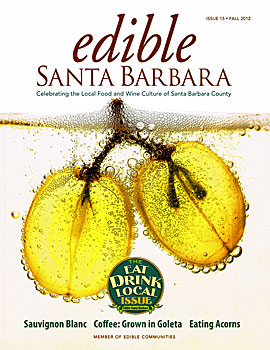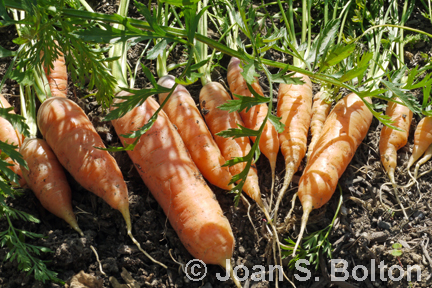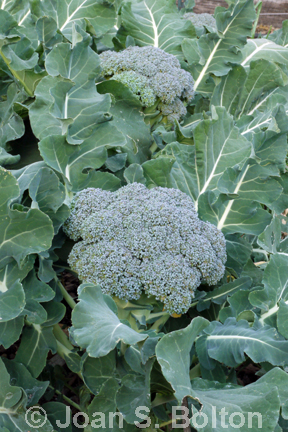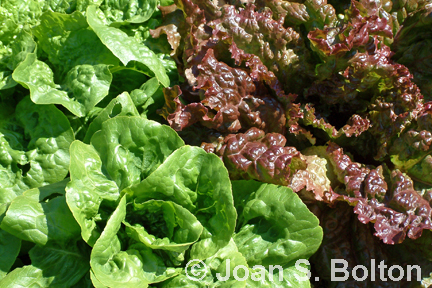Just because we’re heading into winter is no reason to stop growing vegetables. With a shift in focus, there are any number of edibles that you can tend during cooler weather.
By Way of Background

Living on the Central Coast has many virtues, not the least of which is that in the garden, our mild, Mediterranean climate means we can grow crops year-round. But instead of four seasons per year, our edibles only have two: the warm season and the cool season.
Warm-season crops are generally big, robust growers that bear fruit in some form or another. These are our sun-kissed tomatoes, elegant squash and zucchini, crunchy bush beans, succulent corn and sweet and fiery peppers. To mature properly, the warm-weather types need at least six to eight hours of direct sunlight a day, plus plenty of heat. Each has a predictable time line, generally marked on the seed packet or plant tag, with days from planting to harvest ranging from 45 days to 120 days, depending on the variety.
Cool-season crops tend to be more demure in stature and yield edible roots (beets and carrots), leaves and stalks (salad greens and Swiss chard), and flower buds (broccoli and cauliflower). There’s nary a fruit in sight.
Cool-season vegetables require far less sunshine. Four to six hours of direct light is sufficient on the days that the sun does shine. If clouds or rain move in, they may slow down or take a break. But they suffer no harm. When brighter skies appear, they simply resume growing. As a result, during wetter years — or those gifted with a string of warm, sunny days — it can be difficult to predict when exactly a particular edible will be ready to harvest.
Getting Started

One of the keys to successful warm-season vegetables is providing enough water early on, to keep the young plants and their emerging roots well hydrated.
Cool-season crops can face quite the opposite problem.
In a rainy year, and depending on your soil type, they may have trouble drying out.
Excellent drainage is critical. While your cool-season edibles won’t mind any and all moisture that nature provides, they absolutely detest sitting in cold, boggy soil for days on end.
If you have heavy clay, dig down at least a foot and amend the excavated soil with a generous blend of coarse and fine-textured compost to force rough, jagged pathways between the small, slick clay particles. Then shape the amended soil into mounds at least 6 inches high and 12 to 18 inches wide.

If you have coarse, sandy soil, amend with finer-textured compost. In coarse soils, compost replenishes nutrients and acts like a sponge, preventing the nutrients and water from washing away too quickly.Growing cool-season edibles in a raised bed provides an opportunity to adjust both your soil composition and drainage.
But even if your raised bed soil is tip-top at the moment, be sure to mix in at least an inch or two of compost each time you plant.
Or if you garden in that magical mix of rich, loamy soil that already drains well, still consider applying a soil conditioner that contains humic acid or mycorrhizae to boost beneficial microorganisms in the soil. We add new material every time we plant a new crop, and after 20 years, the soil in our raised beds is dark, rich and smells wonderful. Even better, it reliably produces healthy bumper crops.
Also consider growing your cool-season crops in containers, if what you’re growing doesn’t have a big footprint, such as a mixture of leafy greens or several rounds of carrots. Provided they’ll get enough sunshine, you can put the containers close to your front or back door. That way you won’t leave a trail of muddy footsteps each time you traipse back and forth to your garden.
What to Plant Now
Cool-season root crops include beets, carrots, green onions, kohlrabi, leeks, radishes and turnips.
Sow these directly in the garden, as the roots are difficult to transplant. Be sure to net the bed. Foraging birds can pluck the seedlings so rapidly that you might not realize that your seeds ever sprouted.

Leaf and stalk crops include bok choy, cabbage, celery, kale, lettuce, radicchio, salad greens, spinach and Swiss chard.
While you can grow any of these from seed, I like to purchase nursery seedlings for their variety.
For instance, rather than buying a single seed packet and growing 20 Red Sails lettuce plants, I’d rather spend a little more for an assortment of butter, romaine and loose-leaf lettuces.
They’re prettier in the garden and on the plate. And I don’t have to contend with birds gobbling up my tiny little sprouts.
Edible flower buds include artichokes, broccoli and cauliflower. These are the behemoths of the cool-season world, inhabiting far more space in the garden.
A single artichoke plant, with its silvery, serrated leaves, can easily grow 5 feet tall and wide, while broccoli and cauliflower plants grow about 2 feet tall and wide. With their deep, spreading roots, all three are at their best in fertile, well-drained beds.
≈
This article was first published in the Fall 2012 issue of Edible Santa Barbara.
Copyright, Joan S. Bolton. All rights reserved. Reproduction of text or photos in any form is prohibited without written permission.
≈
